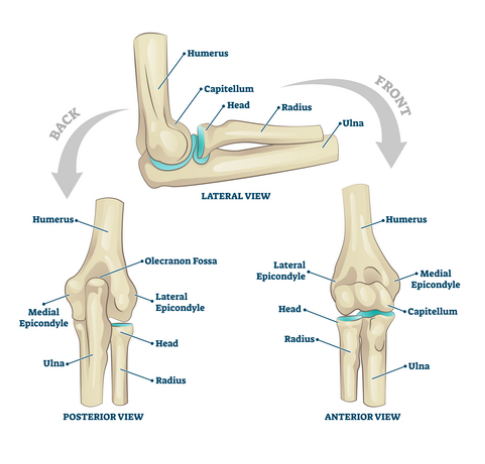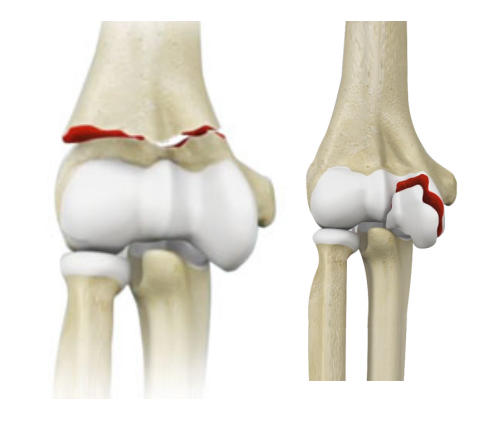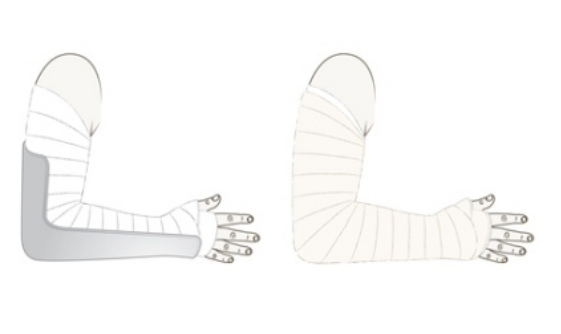The elbow joint is a complex joint of the upper arm which bends and straightens like a hinge. It is also important for rotation of the forearm; that is, the ability to turn your hand in a palm up (like accepting change from a cashier) or palm down (like typing or playing the piano).
Your elbow joint is a joint made up of three bones
The distal humerus or the lower end of the humerus forms the upper part of the elbow and is the pivot around which the forearm bends and straightens.

The radial head or the upper end of the radius is a knobby end with a flat upper surface which glides up and down in front of the distal humerus when you bend your arm. The radial head also rotates around a groove in the upper end of ulna when you turn your wrist up or down.
The olecranon or the part of the upper part of ulna "hooks" the lower end of the humerus, creating a hinge for elbow movement. The bony "point" of the olecranon can be easily felt beneath the skin.
The elbow is held together by its bony architecture, as well as ligaments, tendons, and muscles. In addition to this, major blood vessel and nerves supplying the forearm and hand cross the elbow joint.
For simplicity of understanding, the elbow joint can either break at the lower end of the humerus (arm bone) or at the upper end of the forearm bones (radius/ulna) either individually or in combination.

A distal humerus fracture is a break in the lower end of the upper arm bone (humerus) either extending to the surface of the elbow joint or limited to above the joint. A fracture in this area can be very painful and make elbow motion difficult or impossible. Most distal humerus fractures are caused by some type of high-energy event—such as receiving a direct blow to the elbow or during a road traffic accident. In an older person who has weaker bones, however, even a minor fall may be enough to cause a fracture.
Distal humerus fractures are uncommon; they account for just about 2 percent of all adult fractures. They can occur on their own, with no other injuries, but can also be a part of a more complex elbow injury
Distal humerus fractures are most often caused by:
A distal humerus fracture may be very painful and can prevent you from moving your elbow. Some of the sypmtoms of distal humerus fractures are
Most patients with distal humerus fractures will go to an hospital emergency room for initial treatment. Your doctor will talk with you about your medical history and general health and ask about your symptoms. He or she will then examine your elbow to determine the extent of the injury. During the exam, your doctor will:
Although you may have pain only at the elbow, your doctor may also examine your shoulder, upper arm, forearm, wrist, and hand to ensure that you do not have any other injuries.
Your doctor will order x-rays of your elbow to help diagnose your fracture and also may also order x-rays of your upper arm, forearm, shoulder, wrist, and/or hand to ensure that you do not have any other injuries based on his/her clinical judgement.
In the emergency room, your doctor will apply a splint (like a cast) to your elbow and give you a sling to help keep your elbow in position. This prevents any further movements of the broken fragments and thereby limits the chances of ulnar nerve injury. Immediate treatment may also include medications to relieve pain. Whether or not your fracture requires surgery will then be determined. Some distal humerus fractures can be treated without an operation, but this is rare.

Nonsurgical treatment may be recommended for stable fractures in which the pieces of bone are not out of place (displaced). It may also be recommended for patients who are at higher risk for surgical complications. For example, patients with severe medical conditions may not be able to tolerate surgery or those with severe weakening of bones due to osteoporosis.
A splint will be applied along with a sling to hold the elbow in place during healing. During the healing process, your doctor will take frequent x-rays to make sure the bone has not shifted out of place. Splints are typically worn for 6 weeks before supervised motion is started. If the fracture shifts out of position during this time, you may need surgery to put the bones back together.
Surgical treatment is the most common form treatment to treat fractures of the distal humerus unless the patient falls in non operative category for the reasons listed above.
For severe open fractures such as when there is a wound over the elbow which is contaminated, your doctor may apply an external fixator to hold the bones in place until a second surgery can take place. In this operation, the doctor makes small incisions into the skin and inserts metal pins through the bones. The pins project out of the skin and are attached to carbon fiber bars outside the skin. The external fixator acts as a frame to help hold the elbow in a good position until a second surgery can be performed.
More frequently, the distal humerus fracture is treated with open reduction and internal fixation. During the procedure, the bone fragments are first repositioned (reduced) into their normal alignment and then held in place with plates and screws attached to the outside of the bone.
Like any major surgery, there are certain anatomical considerations the surgeon will contemplate upon and brief you about.
There are risks associated with all surgery. If your doctor recommends surgery, he or she thinks that the possible benefits outweigh the risks. However, there is rare risk of complications with elbow fracture surgery.
Prior to surgery, it is common to experience pain due to the injury. This can be controlled with medications. In severe cases, your doctor may suggest giving a nerve block by referring to a anaesthetist colleague. Most fractures hurt moderately for a few days to a couple of weeks after the surgery. Many patients find that using ice after the slab and stitch removal, elevation (holding their arm up above their heart), and simple, non-prescription medications for pain relief are all that are needed to relieve pain. If your pain is severe, your doctor may suggest a prescription-strength medication, such as an opioid, for a few days. It is important to use opioids only as directed by your doctor. As soon as your pain begins to improve, stop taking opioids.
Whether your treatment is surgical or nonsurgical, recovery from a distal humerus fracture requires much work. During rehabilitation, your doctor or a physical therapist will provide you with exercises to help:
Because nonsurgical treatment can sometimes require long periods of splinting or casting, your elbow may become very stiff. For this reason, you may need a longer period of physical therapy if you are treated conservatively. You will not be allowed to lift, push, or pull anything with your injured arm for a period of time till there is a clinical sign of the fracture uniting.
Depending on the complexity of the fracture and the stability of the repair, your elbow may be splinted or casted for a period of time after surgery. Most patients will begin exercises to improve elbow and forearm motion shortly after surgery, sometimes as early as the next day. It is extremely important to perform the exercises as often as directed. The exercises will only make a difference if they are done regularly.
Even with successful treatment, some patients with distal humerus fractures may experience long-term complications.